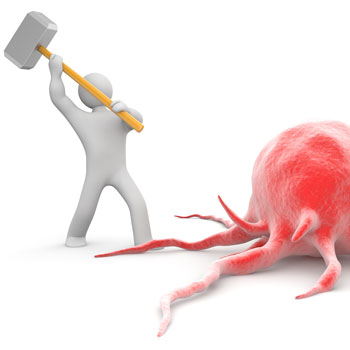By Judith E. Glaser | psychologytoday.com
Published: September 26, 2014
 What is true for human cells applies to human cultures.
What is true for human cells applies to human cultures.
On September 11, 2001, the day World Trade Center was attacked, I was diagnosed with breast cancer. It’s a day the world will never forget, and one I have relived a thousand times.
Sitting in the doctor’s office, at 9:15 AM, the words come softly out of my physician’s mouth: “You have breast cancer.” In the background, I hear people screaming, “It’s not possible…” I think they are speaking about me. But they are not. As the first of the twin towers tumbles down to the world’s horror, I can’t see it, but I can feel it. I sense my life is over—I have breast cancer.”
Now, 13 years later, I can see with greater clarity. I am healthy and thriving—with lessons to share that changed my consulting practice forever.
Fateful Intersections through Conversations
When I was young, my mother died of cancer; and while I knew cancer was in my family’s DNA, I couldn’t anticipate what would happen to me. One week after my operation, my husband became the CEO of an early-stage cancer research company at NYU School of Medicine. His team of scientists uncovered a new treatment for cancer—one that turns cancer cells into natural, healthy functioning cells. How incredibly fateful! As I was being treated with chemo to kill the cancer in my body, my husband and I conversed about the connection between healthy cells and healthy organizations.
Toxic cultures behave like cancer cells; healthy organizations behave like healthy cells. This linkage created a framework that I call Conversational Intelligence™ (C-IQ).
C-IQ reveals three levels of conversation that drive human interaction. There is a healthy dimension and an unhealthy dimension:
1. Level 1 Transactional Conversations are the most basic interactions we have with others. These asking and telling conversations confirm what we already know. When they are healthy, they help us connect with others and validate our realties; when they are unhealthy, we stop listening to others and fall into a tell-sell-yell mode, which closes down conversations and activates our fear networks.
2. Level 2 Positional Conversations are characterized by advocating and inquiring dynamics and focus is on defending what we know. The healthy side of these conversations is when we move people forward toward shared goals through influence; the unhealthy side is when we become addicted to being right and stop listening or listen only to influence people to our point of view. Our minds are not open to influence as we converse to ensure our voice is heard and followed.
3. Level 3 Transformational Conversations go beyond confirming what we know and defending what we know. They require an open mind to listen, connect, and take in what others are saying. We become open and willing to change our minds as we connect with others more deeply to create a shared view of reality. The healthy side is what I call co-creating conversations® because we are building one view of reality and a view of shared success. The unhealthy side is that we can get caught in all talk and no action, talking in circles, keeping us stuck in the present and maybe even in groupthink.
Three Transformational Principles: The DNA of Healthy Conversations
When I compared healthy and unhealthy cells and cultures, I noted several parallels between Cell Behavior and Organization Behavior. First, cancer depletes life energy from a system. Cancer cells behave as if they are in survival mode (I-centric); healthy cells are in a growth mode (WE-centric). The secret to reinstructing a cancer cell to become a healthy cell again is revealed in three principles that also apply to transforming toxic cultures and relationships into healthy ones: these principles are the DNA of Healthy Conversations.
Principle 1: Ensure Dialogue is open, healthy and transparent. When the body is healthy, the immune system works to ensure that threats are attacked immediately. Immune system flags arise from cells, directing the immune system to know how to target their action and marshal the internal resources to restore health. When our bodies are healthy, each cell has a responsibility to the whole—and signals where help is needed from the immune system. Everyone works as a connected, healthy team, in partnership. The cells and system have a dialogue, from which arises higher immunological support to handle threats. When cancer forms, normal cells lose their system flags—we avoid conflict and don’t speak up. We pull away and hide, acting toxic in the same way cancer cells become toxic in the body.
Unhealthy Signals: Making yourself the center of attention.
Healthy Sgnals: Making your organization the center.
When leaders make themselves the center of attention, ignoring signals coming to them, the culture breaks down. In healthy organizations, each person sees challenges and speaks up. People come together, put issues on the table, and work with their leaders to take on challenges together. They create safe environment where everyone can make their issues, concerns and beliefs visible. Having healthy dialogue and making our flags visible and our belief systems transparent is core to sustaining a healthy organization.
Principle 2: Become more sensitive to others’ Needs and Aspirations. When cancer cells grow, the cells lose their sensitivity to each other and grow anywhere they can. The chemistry for facilitating conversations between cells, called Contact Inhibition Factor (CIF), dries up as the cells break away from their cell partners, seeking a new form of contact. Without CIF, the cancer cells can’t find contact points and invade the body, growing into tumors that block the normal functioning of organs and the body’s systems for sustaining health. These cells can’t give and receive healthy feedback.
Unhealthy Signals: Insensitivity to others;
Healthy Signals: Sensitivity to others.
Creating a feedback-rich culture enables us to establish healthy conversations and relationships, even when the conversations are difficult. Greater awareness emerges so that we don’t “grow all over each other.” Rather than create cultures full of territorialism and competition, we reach out and connect with others, give and receive healthy feedback, ask for support, and enable each other to achieve our highest aspirations.
Principle 3: Be open to Adapt to new ways of thinking. Cancer cells multiply by creating their own growth factors. They build a vascular system (angiogenesis) that supplies them with oxygen and nutrients, enabling them to grow rapidly. They become self-sustaining and encapsulated from the rest of the system, drawing nutrients from inside the system for their sustenance. Healthy cells are serum-dependent and need nourishment from the outside to grow.
Unhealthy Signals: Entrenchment in your own point of view;
Healthy Signals: Open to be influenced and change your mind.
When we focus on the past, get addicted to being right or entrenched in our own point of view, we become so convinced we are right that we stop listening or being open to others’ perspectives. This internal view saps energy and creates blind spots and biases. Instead, we need to turn outward and connect in healthy ways with others—to learn, grow and nourish each other; to support, engage, build partnerships, collaborate and innovate, and grow toward greatness.
By mastering the three Levels of C-IQ and their principles, we activate our Vital Instincts, rather than our Survival Instincts. We ward off toxicity, and we create energetic, transformational conversations, teams and organizations. We become a healthy, thriving organization.
“To get to the next level of greatness, depends on the quality of the culture, which depends on the quality of the relationships, which depends on the quality of the conversations. Everything happens through conversation!” Judith E. Glaser








